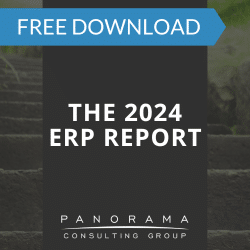At the beginning of your ERP journey, you’ll probably discuss with several ERP vendors and consulting firms the costs associated with different ERP systems. Then, during ERP implementation, project managers will monitor business benefits and costs. Measuring the benefits of ERP is important during this time.
Once you’re live on a new ERP system, the measuring and monitoring does not end. This is the time to get a post go-live measurement of ERP system benefits realization and return on investment.
While ROI may seem subjective, you can actually use a generic formula and common guidelines. Learn how to measure ROI and benefits realization after ERP system go-live.
ERP Selection Guide
This ERP Selection Guide will help you select technology that will support your organization for at least the next ten years.
What is ERP ROI and How is it Measured?
The classic definition of ROI is a percentage or ratio of the value of an investment to its cost. Here is a simple formula to calculate ROI as a percentage for any investment:
ROI = [(Value of investment – Cost of investment) / Cost of investment] * 100%
Since the value of an ERP project is subject to a variety of factors, let’s first discuss how to calculate the cost of an ERP project.
How to Calculate ERP Costs
During the ERP selection process, different ERP vendors will quote total cost of ownership based on factors like licensing and implementation costs. These amounts are estimated before implementation, so once you go live, they might have change.
Some of these early discussions may not include factors such as hardware expenses and change management costs. After go-live, we recommend looking back on the actual expenditures from purchasing through implementation and go-live. Here are a four average ERP cost factors to consider:
1. Licensing
The number of licenses needed is probably the one area of expense that won’t change much from initial quoting. However, during implementation you may stumble across scenarios where you need a different type of license than initially thought.
For example, let’s say you’re implementing a retail ERP solution for your brick and mortar stores and your headquarters. Initially, you may estimate for a more restricted license for the stores, as the thought is users will access the ERP system via a point of sales terminal for simple actions like performing sales and issuing returns.
As business processes become more defined, you discover that the stores actually need a full license to access modules such as inventory management to help customers determine the availability of product. This change in access required likely will increase your licensing costs.
2. Hardware
If your ERP software is deployed on-premise, the bulk of your hardware costs will come from acquisition of new servers and networking equipment. On the other hand, if your ERP system is hosted in the cloud, your hardware costs will be minimal. With cloud ERP systems, most hardware costs are associated with peripheral devices such as new POS terminals, payment devices, warehouse scanners, scales or printers.
3. Technical Implementation
Whether you implement in-house or outsource some heavy lifting to a consulting firm, your costs will include hours billed for activities like requirements gathering, configuration, customization, deployment and testing. Be on the lookout for less obvious expenses, like travel dollars for consultants or overtime pay for your full-time employees.
4. Change Management
Money spent preparing employees to use the new ERP system and new business processes is also a factor in total ERP cost. The hiring of external trainers or change management experts will fall into this category. Any kick-off assemblies, training classes or promotional materials – no matter how small the expense – should be included in the total cost.
How to Calculate ERP Business Benefits
Now for the more subjective part of the ROI equation: the value of your ERP project. There are many ways to measure the value of an ERP project. It varies from business to business. However, there are a few factors that are commonplace across most industries:
1. Reduced Operating Expenses
One easy metric to find while measuring your ROI is your new monthly operating expenses post go-live. Operating expenses can include a variety of factors, from the real estate and utility expenses for housing physical servers, to hourly rates and benefit compensation for your workers.
Your accounting department probably has this number on hand and is monitoring it regularly, but if you want to get a detailed understanding of how an ERP system can reduce operating costs, it’s worthwhile to dig into the specifics.
After you’ve determined the cost of each of the following three categories, add them together to get your latest operating cost. Compare this number to the operating expenses on your old system and you’ve got your first metric for the value of your ERP project.
1. Labor
Tasks and processes that used to take skilled manpower to complete can be automated or extremely streamlined with a new ERP system.
2. Logistics
One of the most common ERP business benefits is having all modules, from sales to manufacturing, integrated and pulling from a single set of data. This especially is important when it comes to logistics.
For example, imagine your old system did not have dock management functionality. Delivery drivers were showing up at your warehouse at different times throughout the day, sometimes even having to wait for an open dock.
If your new ERP system has dock management features, you can schedule pick up dates and times with your carriers and better plan your picking and shipping labor throughout the week. This can lead to less pickups which will lead to lower shipping costs.
3. Utility Costs
If you move from an on-premise ERP system to a cloud-based ERP solution, your utility costs will probably decrease. Without the need for excess physical space for servers and networking equipment (and the AC systems to keep them cool) your utility bills will decline. It may seem like a small drop in a large bucket, but every drop counts!
2. Shorter Sales Cycle
After implementation, you may notice a decrease in duration of your sales cycle. Quicker lead to sales time due to enhanced tools provided by your new ERP system is most likely the cause.
Some ERP software solutions come with enhanced customer relationship management capabilities. These capabilities are tightly integrated with the marketing, sales and logistics modules within the ERP system, making the quoting and sales process more efficient.
3. Streamlined Supply Chain and Lower Cost of Goods
Another value measurement to consider is decreased cost of goods due to a streamlined supply chain.
For example, say your veteran purchasing agents know which vendors give quantity discounts for certain types of products. This information might not be in your old system because your purchasing team considers this tribal knowledge and is difficult to input in the system.
However, if with your new ERP system purchasing agreements can be easily managed, it would be to the benefit of all buyers (newbies and veterans alike) to use the system to get the best deals.
Do the Math: How to Measure ROI
Now that you’ve calculated your total ERP cost and value, it’s time to measure your ROI. Returning to our ROI equation, plug in your findings below:
ROI = [(Value of investment – Cost of investment) / Cost of investment] * 100%
Is your ROI less than expected? It could be in the way you’re measuring your total ERP value or perhaps there are potential ways to increase certain business benefits, like saving on operating costs. Maybe there’s a factor specific to your industry that’s not covered here. Also, keep in mind that ROI increases over time, some companies see the biggest return within five to ten years.
We help companies measure ROI after ERP system go-live by preparing them before implementation. We help them define key performance indicators and create an ERP benefits realization plan. This makes calculating ROI much easier for our clients, and it can even lead to a higher ROI since it enables them to design their ERP project plan to achieve specific goals.
Whether you’re in the early stages of your project or ready to go-live, Panorama’s ERP consultants can help your company measure (or prepare to measure) ROI. Request a free ERP consultation to learn more.













